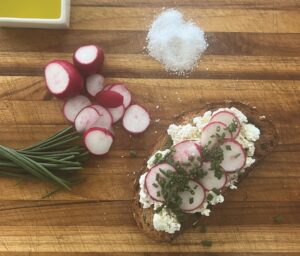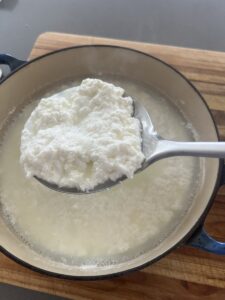It’s the end of our stay in my other hometown. We fill the car with our suitcases plus all our Mardi Gras accoutrements, including wigs, hats, a sequined dress, and a remarkable purple faux fur handbag bought especially for this year’s Purple Party. Last in is a Styrofoam chest packed with 20 pounds of smoked sausage.
After two months in New Orleans, we’re ready to return to Truro and we don’t mind the road trip that will get us there. The landscape can be lovely at this time of year, and we’ll listen to audio books to pass the time. What we don’t look forward to is the highway food, though we always manage to find something good on our annual trek. This year we added Juniper Hill in Annandale, N.J. to our list of places that are worth the stop.
We got there at the end of a second long day of driving through heavy rain. As the bartender set black Manhattans in front of us, my eye went to one of the appetizers on the menu: “hand-dipped ricotta,” it said. They served it with extra virgin olive oil and bird’s-eye chiles on sourdough toast.

I’ve made enough ricotta to know that dipping the curds out of the whey rather than pouring them through a cheesecloth will yield a lighter, fluffier cheese. Someone in the kitchen at Juniper Hill knows what they’re doing.
Ricotta is Italian for “re-cooked.” It is traditionally made from the whey left over from cheesemaking. Casein proteins are removed from the milk in making the primary product. But when the whey is reheated, more proteins clump together into fluffy fresh curds.
My recipe uses fresh milk, but it has to be the right milk: cow’s or sheep’s milk will work, and the less processed the better. I don’t have access to raw milk and it’s hard to find unpasteurized here, so I use pasteurized whole cow’s milk. It works fine — just be sure not to buy ultra-pasteurized milk because the high heat used in the process makes curd formation very difficult.
The milk must be heated to exactly 185° F to achieve the separation of the curd without the need for excessive acid. Use a good instant-read thermometer.
Next, while many artisanal ricotta-makers eschew the addition of acid, my attempts to use heat alone have been unsuccessful. I use the minimum amount of the most neutral-flavored acid available — white vinegar — to ensure the ricotta tastes sweet and milky.

Once the curds have formed, I continue to cook them at between 175° and 185° F to allow the flavor to develop and to keep the curds tender and light. Then I dip the curds out of the whey with a slotted spoon and set them gently in a cheesecloth-lined colander to drain. Pouring the mix into the colander clogs the cheesecloth with tiny particles of curd and the cheese can become waterlogged and heavy. I drain the cheese for 5 to 10 minutes — more than that makes the curds drier than I like.
Ricotta isn’t hard to make, but I hear you asking, “Why go to the trouble when you can just pick up a pint at Stop & Shop?” All I can say is: make it once and you’ll understand. Homemade ricotta is completely different from what is available commercially.
When you want a subtle, ethereal, and incomparably creamy cheese to whip into a quick appetizer or toss with some chopped walnuts, olive oil, and fresh soft herbs into a bowl of hot pasta, this is the ticket. Or stir half a cup into a tomato-based pasta sauce for a transformative experience. David Tanis has a pasta with zucchini, ricotta, and basil that I make all summer long. I also like to whip it in a food processor with salt and a couple of teaspoons of cream until it’s smooth and light. Then I heap it into a bowl, drizzle it with olive oil and something with kick like harissa or chili oil, and serve it with cut vegetables or crusty bread.
My favorite way to eat it is the simplest. Just spread the cheese on toasted crusty bread and top with sliced spring radishes, chives, and a drizzle of olive oil. And maybe some sliced chiles — like they do at Juniper Hill.
Homemade Ricotta
Makes about 1½ cups
½ gallon whole milk, not ultra-pasteurized
2 Tbsp. plus 2 tsp. distilled white vinegar
- Pour the milk into a heavy pot and warm over medium heat until milk registers 185° F on an instant-read thermometer. Add vinegar and stir briefly; curds should quickly begin to form. Once the curds have formed throughout the pot, stop stirring.
- Hold the milk mixture at 185° F for 20 minutes. The temperature will fluctuate a bit, but try to keep it in the range of 180° to 190° F, testing frequently with the thermometer. Meanwhile, line a strainer or colander with a double layer of cheesecloth.
- Once the ricotta is cooked, use a slotted spoon to transfer the curds to the strainer and allow them to drain for between 5 and 10 minutes or until you see the consistency that you’d like.
Drained ricotta can be covered and refrigerated for a few days, though it’s best eaten sooner rather than later.



